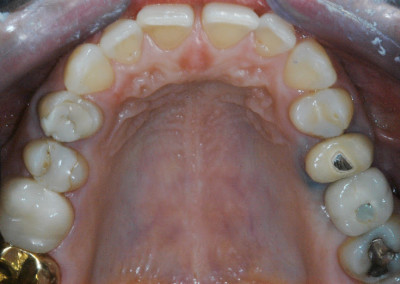Balancing a previous collapsing bite with old dentistry that is not holding and finances is the ultimate juggling act. “Where do we start?” and “what sequence?” are the two questions that patient and dentist must agree on. Losing first molars at a young age are often the beginning of the end (destroyed occlusion). This case started five years ago and took a couple of years of damage control, fillings, endos on #2 and #20 and a prayer that the old endos on #4 and #12 would hold. The first goal was comfort and control of the envelope of function by slowly eliminating posterior interference. (https://digitalocclusion.com/digital-occlusion-concepts/anterior-guidence)Once the implants were placed, the entire case changes. The right posterior bite held up until help came with posterior left side prosthetic support. The patient now has comfort, good function and can maintain a healthy occlusion. Next step is to restore the left corner and #20 and #12. The remaining dentistry of six to eight crowns can be accomplished at two per year.
Good condyles and good anterior teeth saved this bite and allowed us to restore the posterior left and save this occlusion. The force pattern is center in general and the anterior teeth are able to protect the posteriors in most closures. This pattern will get better when teeth #12 and #20 are restored.
FUNCTION HEALTH
This would of been a different case if the patient could afford the entire reconstruction. The issue at first was to stop the left side posterior collapse. When the tooth pain and left condyle pain were eliminated, the patient had enough confidence to save the bite.
FUTURE CONSIDERATIONS…
The future is the same goal as the past; save the occlusion and continue to monitor condyle function and stress on the posterior teeth. The patient is a believer in the T-Scan because the original scan was 90% dominated by force in the posterior left.




